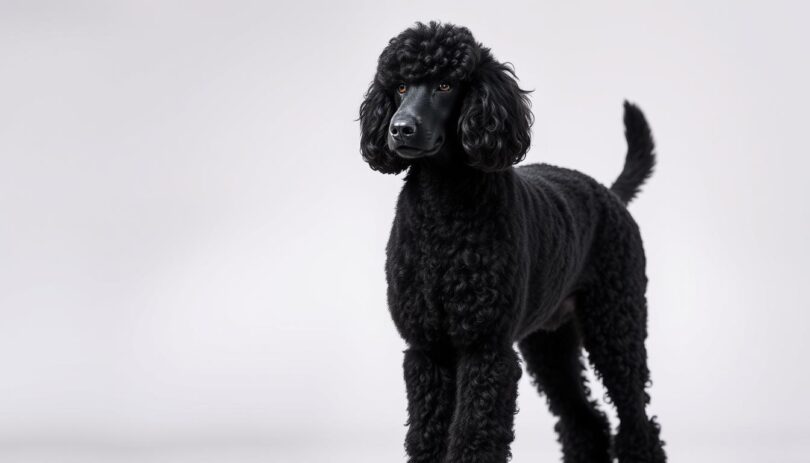Did you know standard poodles rank among the top 5 most intelligent dog breeds? Their problem-solving skills and trainability make them ideal companions for families and active individuals alike. This article dives into everything you need to know about these elegant, curly-coated dogs—with a special focus on the striking black-coated variety.
Whether you’re considering bringing home a puppy or simply want to understand the breed better, we’ll guide you through essential care tips and breed traits. From grooming routines to exercise needs, we break down what makes these dogs unique while highlighting their adaptability to different lifestyles.
You’ll discover practical advice backed by expert sources, including how to maintain their signature coat and address common health considerations. We’ll also explore why they’re celebrated as both working dogs and affectionate family pets, blending brains with loyalty.
By the end of this guide, you’ll feel confident navigating the joys and responsibilities of owning one of these remarkable canines. Let’s start your journey toward becoming a well-prepared pet parent!
Understanding the Black Standard Poodle
Originating as skilled water retrievers, these dogs have a heritage rich in both function and form. Let’s explore how their journey from practical working roles to cherished companions shaped their modern identity.
History and Origins of the Breed
First bred in Germany as duck hunters, their name derives from the German word “pudel,” meaning “to splash.” By the 18th century, French aristocracy popularized them as luxury companions. Over time, breeders refined their traits to emphasize intelligence and elegance, leading to their prominence in dog shows worldwide.
Distinctive Physical Traits and Characteristics
Their iconic curly coat serves a purpose beyond looks—it originally protected them from cold water. While colors vary, solid hues like deep ebony remain highly sought after. Athletic builds with square proportions and expressive eyes create a balanced, regal appearance. Modern standards prioritize both aesthetics and structural soundness, ensuring they excel in competitions and family homes alike.
Breed Characteristics and Temperament
Intelligent and adaptable, these canines form deep bonds with their families. Their lively nature thrives in homes where mental challenges meet affectionate companionship. Let’s explore how their physical and behavioral traits shape daily life with owners.
Health and Wellness Considerations
Proactive care keeps these dogs thriving. Hip dysplasia, eye conditions, and sebaceous adenitis (a skin disorder) rank among common concerns. Reputable breeders prioritize OFA-certified hip evaluations and annual ophthalmologist exams to reduce risks.
Experts recommend bi-annual vet check-ups for early detection. Pair this with daily exercise—30-60 minutes of walks or puzzle games—to maintain joint health and cognitive sharpness. A 2023 study by the AKC Canine Health Foundation notes that structured routines prevent boredom-related behaviors.
Family, Social, and Temperament Traits
Their playful yet gentle demeanor makes them excellent with children and other pets. They crave interaction, often shadowing family members during activities. Without proper socialization, however, shyness or aloofness may develop.
Training sessions double as bonding opportunities. Positive reinforcement techniques work best, leveraging their eagerness to please. Agility courses or obedience trials channel their energy constructively, reinforcing the breed’s working-dog heritage while strengthening trust.
Puppy Profiles and Available Black Standard Poodles
Choosing the perfect companion starts with understanding their unique personalities and needs. Below, meet four exceptional puppies ready to bring joy to loving homes. Each has distinct traits that cater to different lifestyles, from active families to those seeking a gentle snuggle buddy.
Show-Stopper Puppies: Lincoln and Friends
Lincoln stands out with his jet-black curls and confident posture. Born March 15, 2024, this male pup is projected to reach 58 lbs based on his parents’ weights (62 lbs dam, 60 lbs sire). His alert expression and playful energy make him ideal for agility training or show circuits. Watch his training video to see his potential.
Overview of Ned, Nancy, and Nova
Ned (April 2, 2024) charms everyone with his outgoing nature. At 22 lbs already, he adapts quickly to new environments—perfect for busy households. His favorite game? Fetch with squeaky toys!
Nancy, a 19-lb female born March 28, melts hearts with her calm demeanor. She’s expected to mature around 55 lbs, matching her mother’s build. Her soft coat and gentle eyes make her a therapy dog candidate.
Nova sports a rare touch of white on her back paws. This affectionate girl (March 22, 2024) thrives on cuddles and learns commands rapidly. Check her interaction reel to see her bond with children.
All puppies come from health-tested lineages documented in their profiles. For details on availability or to schedule a meet-and-greet, please click the links below each description. Time-sensitive inquiries are encouraged—these pups won’t stay available long!
Caring for Your Standard Poodle: Health, Grooming, and Nutrition
A thriving companion starts with consistent care routines. Proper grooming, balanced meals, and preventive health practices work together to keep these intelligent dogs energetic and happy. Let’s explore how to maintain their signature elegance while supporting their physical needs.
Grooming Tips for a Velvet-Soft Coat
Weekly brushing prevents mats and distributes natural oils. Use a slicker brush followed by a comb for curly coats. Bathe every 3-4 weeks with hypoallergenic shampoo to avoid skin irritation.
Trim nails monthly and clean ears weekly to prevent infections. Professional grooming every 6-8 weeks maintains their sculpted look. For hybrid breeds like the best poodle mixes, adjust techniques based on coat type.
Feeding and Nutrition Essentials
High-quality dog food with 25-30% protein supports muscle health. Puppies need 3-4 small meals daily until 6 months old. Adults thrive on two measured portions to avoid overeating.
Include omega-3 fatty acids for coat shine and joint support. Always provide fresh water—dehydration risks spike during playtime. Watch for dull coats or lethargy, which may signal dietary gaps.
Consult your vet to tailor portions as your dog ages. Pair meals with daily walks or puzzle feeders to stimulate their mind and body. Consistent routines build trust and long-term wellness.
Expert Insights on Poodle Breeding, Color Genetics, and Care
Breeding programs shape more than just coat colors—they safeguard the future of entire bloodlines. Responsible practices balance aesthetic goals with long-term wellness, ensuring each generation thrives. Let’s explore how modern approaches preserve both beauty and vitality in these elegant dogs.
Diversity in Color and Conformation Selection
Phantom and parti-colored coats are gaining acceptance despite historical controversy. These patterns emerge from recessive genes requiring careful pairing. Breeders now prioritize genetic diversity by blending show-type lines (known for structure) with retriever lines (valued for athleticism).
This cross-pollination strengthens traits like joint stability and temperament. For example, pairing a conformation champion with a working-line dog reduces exaggerated features while enhancing agility. The result? Puppies that excel in both competitions and active homes.
Maintaining Genetic Health and Low Inbreeding
Low inbreeding coefficients (below 5%) minimize risks of inherited disorders. Reputable breeders use DNA tests to screen for 30+ conditions, including progressive retinal atrophy and von Willebrand’s disease. Annual OFA certifications for hips and elbows are non-negotiable.
Open-source pedigree databases help track lineage overlaps across generations. By collaborating with global networks, ethical programs introduce new genetic material without compromising breed standards. It’s a meticulous process, but one that ensures healthier litters over time.
Your role? Always ask breeders for test results and lineage documentation. This transparency builds trust and supports the breed’s enduring legacy.
Connect with Us to Welcome Your New Black Standard Poodle
Your journey to finding the perfect canine companion starts here. Our experienced breeders raise every puppy in a loving family environment, prioritizing health and socialization. Each litter comes from OFA-certified parents with weights ranging 55-62 lbs, ensuring strong genetic foundations. Detailed lineage records and health guarantees are always available.
Ready to meet your match? Call us at (555) 123-4567 or visit our contact page to schedule a virtual meet-and-greet. Share your lifestyle preferences—we’ll help you choose a puppy whose temperament aligns with your household. Don’t forget to click individual inquiry links for videos showcasing each pup’s personality!
Join a supportive network of owners who value transparency in breeding practices. Whether you seek a show prospect or a cuddly family addition, we’re here to guide you every step. Let’s make your dream of welcoming an intelligent, loyal dog into your home a reality.
FAQ
How do I maintain a velvety coat on my dog?
Regular brushing (3-4 times weekly) with a slicker brush and professional grooming every 6-8 weeks prevents matting. Use sulfate-free shampoos like Earthbath Hypoallergenic to preserve natural oils and enhance shine.
What health screenings should ethical breeders provide?
Reputable breeders conduct OFA hip evaluations, CERF eye exams, and genetic testing for Addison’s disease. Always request documentation through platforms like OFA.org before committing to a puppy.
Are darker-coated puppies prone to color fading?
Some may develop silver undertones due to the “fade” gene. While not a health concern, those seeking permanent jet-black coats should verify parental lineage and genetic testing results for the F locus (Progressive Graying gene).










Leave a Comment